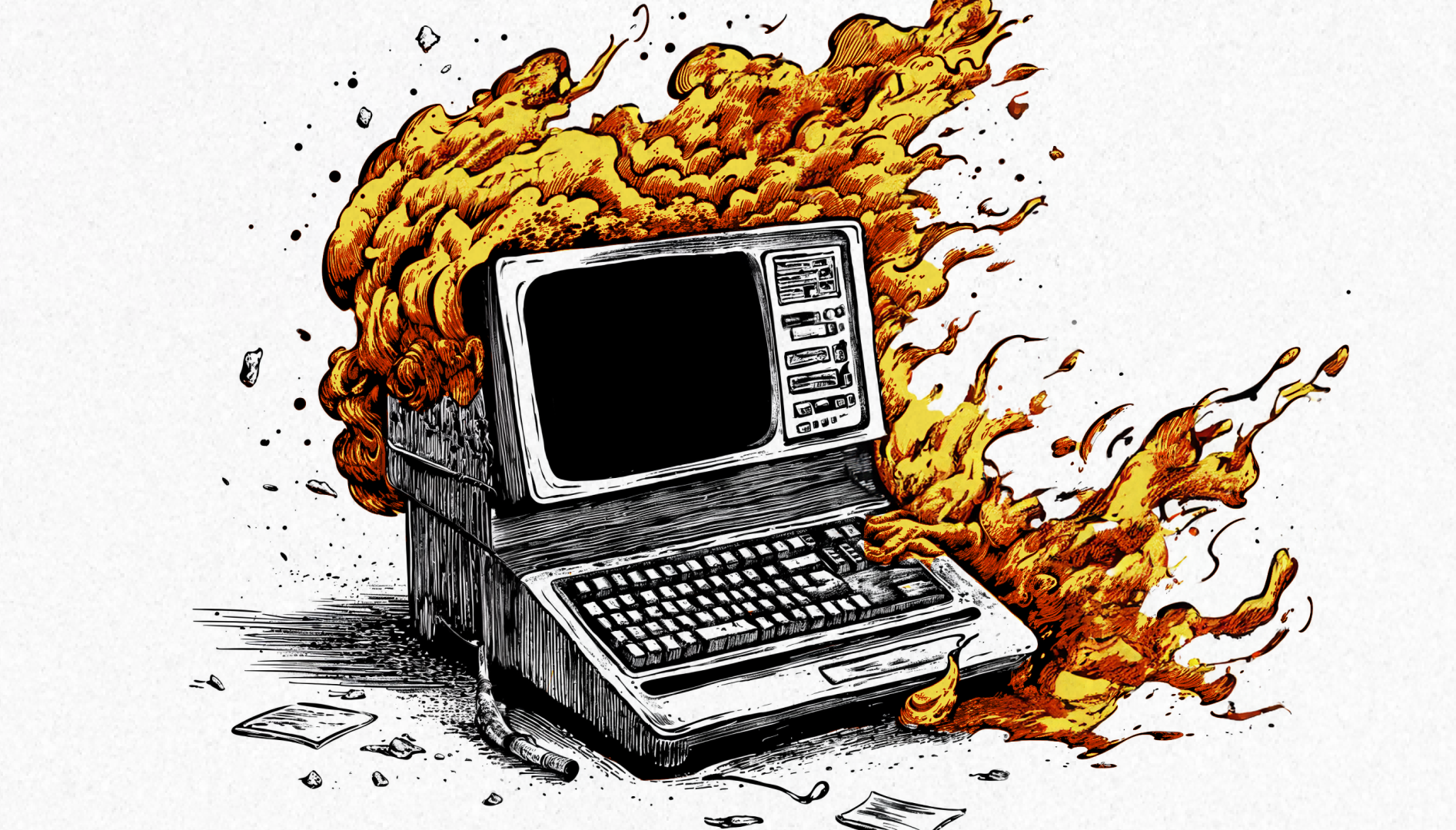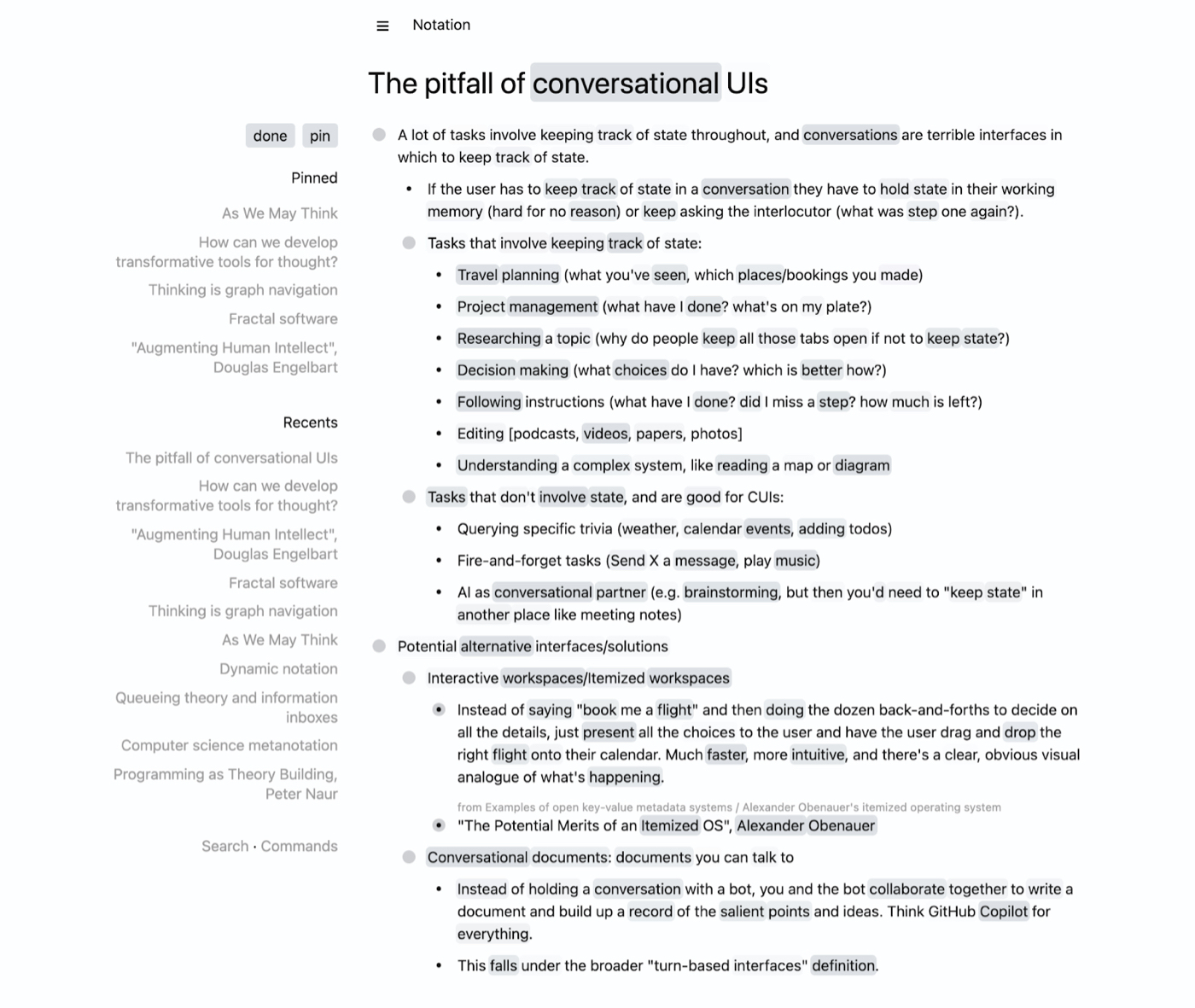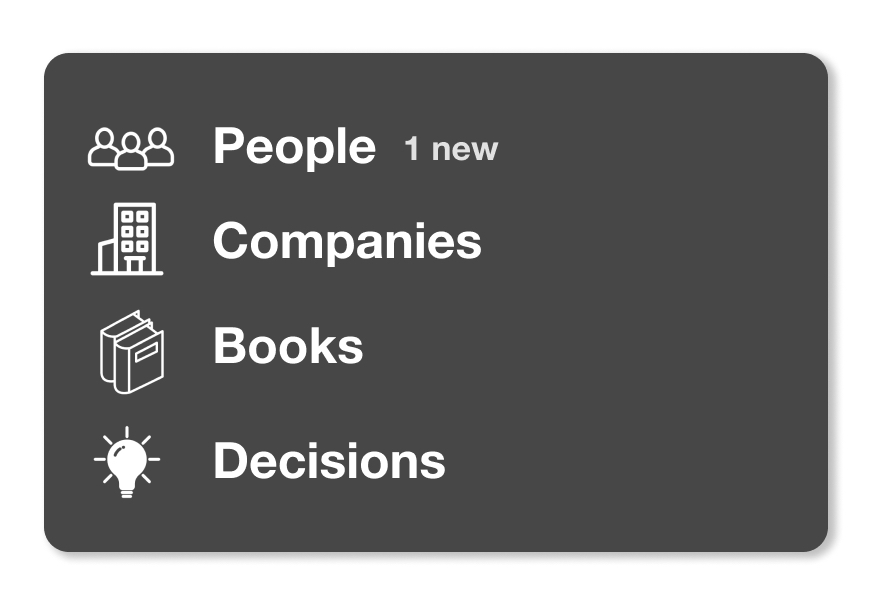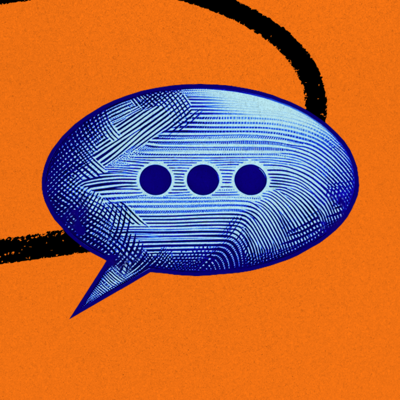
Sponsor Every
Do you run a software company looking to reach an audience of early-adopters? Consider sponsoring our smart long-form essays on tech, AI, and productivity:
I hate to be the bearer of bad news, but all of the time we’ve spent organizing our notes was probably wasted.
Instead, in the immediate future, our notes will be organized for us by large language models (LLMs) like GPT-3. Let’s explore.
. . .
Note taking is building a relationship with a future version of yourself.
Notes record facts, quotes, ideas, events, and more so they can eventually be used to make better decisions, create more interesting writing, and find solutions to problems.
For a long time, the way we’ve tried to make this relationship work is by creating organizational systems. The best way to make sure future versions of ourselves had the right notes at the right time was by constructing Rube Goldberg machines of tags, notebook hierarchies, and bi-directional links so that we could pull up our notes when we needed them. Or at the very least, we could easily find them through search if we knew what we were looking for.
But ultimately, the organizing solutions we’ve built are brittle. We build and abandon new systems all the time, and rarely, if ever, go back to look at old notes. Tags get created and then abandoned. Links rarely get followed. And we feel guilty: there’s a lot of value locked up in what we’ve collected over the years, if we could just figure out how to use it. Paying for a new notes tool is like signing up for a gym membership on January 1. You know you’ll abandon it, but the money you spend soothes your anxiety about not making the most of what you have.
AI changes this equation. A better way to unlock the value in your old notes is to use intelligence to surface the right note, at the right time, and in the right format for you to use it most effectively. When you have intelligence at your disposal, you don’t need to organize.
If we want to understand how AI fixes organizing, first we need to understand why organizing notes is so hard. Then we can talk about what might be different about it in the future.
Why organizing notes is so hard
The more precisely we know what to use a piece of information for, the more easily we can organize it.
The problem is, we put things into notes because we don't know what we'll use them for. You write down a quote from a book because you could eventually use it in 1,000 different ways. You could use it to help you make a decision, or write an essay, or lift a friend’s spirit when they’re going through a tough time (and you might use it for all three). Same thing for writing down notes from a meeting, or thoughts about a new person you met.
As I argued in “The Notetaking Cold War,” this makes finding a single organizing system for your notes quite challenging. You’ll continually reorganize your system, or feel a pull to put a note in many different places, or tag it to make sure it pops up again in different contexts.
This usually doesn’t work so well, and even when you do bump into an old note at the right time, you’re faced with another problem:
Looking at old notes is a bit like looking at stale garbage.
A note that’s been dashed off in a meeting or hurriedly taken down in the middle of the night when you get an idea is usually hard to understand, and takes a while to parse. As I wrote in “The Fall of Roam,” when you read an old note you have to load its context back into your head about when you took it and why before you understand what it’s saying, and whether or not it’s relevant to the task at hand.
So you rarely go back to use your old notes. It’s too cognitively expensive and not rewarding enough. For an old note to be helpful it needs to be presented to Future You in a way that clicks into what you’re working on instantly—with as little processing as possible.
This is where large language models come in.
How AI models solve the note organizing problem
AI models like GPT-3 can solve organizing in a few key ways.
First, they can automatically tag and link notes together with no manual work required. It doesn’t even require an LLM—there are less advanced, cheaper models that can do this out of the box today.
Second, they can enrich notes as you’re writing them and synthesize them into research reports, eliminating much of the need for tagging and linking in the first place.
Third, they can resurface key information from previous notes into a CoPilot-like experience for note-taking. This makes searching through old notes unnecessary and helps you bring to bear all of the information you’ve ever written down every time you tap a key.
Let’s break down each of these.
Automatic tagging, linking, and taxonomies
At the most basic level, the tagging and linking required by current note-taking systems can be done by an LLM (or another, simpler machine learning model).
Entity recognition is cheap and reliable enough for a model to find people, places, companies, books, and other things that repeatedly pop up in your notes. Researchers like Linus Lee, who I interviewed previously, are building versions of this for themselves. His demo doesn’t even use entity recognition, just word frequency tracking, to make the backlinks. These technologies will get more advanced over time.
Source: Linus Lee
Beyond tagging and linking, LLMs can help create an automated taxonomy of your notes that makes it easier for you to navigate through them. Think something like the Apple Photos experience, but for your notes:
Source: Me playing around in Figma.
These taxonomies can even be created on the fly for new projects, so as your needs change, your notes can reorganize themselves into new views that help you navigate them more effectively. A simple example might be something like an automatically updating list of every book you’ve read this year. I’ve been banging on this drum for the last two years, and the time has finally come for these kinds of automated taxonomies to happen.
The real power of AI models for organizing goes beyond taxonomizing, though.
Automated research reports
LLMs can enrich and write your notes for you. They can synthesize and write a report based on everything you’ve ever written about a topic, so you can load it into your brain without having to ever go back through your archive.
Think about starting a project—maybe you’re writing an article about a new topic—and having an LLM automatically write and present to you a report outlining key quotes and ideas from books you’ve read that are relevant to the article you’re writing.
Source: This is one thing I imagine ChatGPT will do in the future.
If you were confident that this would be done for you in a high-quality way, you’d never worry about how to tag or link a quote from a book or an article again. You’d just file it into your notes archive and feel confident that the software—acting as a research assistant—would find and present it later for you.
There are deeper implications, though. Our notes are a reflection of our lives. Think about using an LLM to summarize a key relationship or pattern in your thinking over time. It could produce a history of your mind on a particular topic, including a summary and a timeline of key events that could help you understand yourself, and your world, better.
This is possible today—someone just needs to build it.
CoPilot for notes
Research reports are valuable, but what you really want is to mentally download your entire note archive every time you touch your keyboard. Imagine an autocomplete experience—like GitHub CoPilot—that uses your note archive to try to fill in whatever you’re writing.
Here are some examples:
- When you make a point in an article you’re writing, it could suggest a quote to illustrate it.
- When you’re writing about a decision, it could suggest supporting (or disconfirming) evidence from the past.
- When you’re writing an email, it could pull previous meeting notes to help you make your point.
An experience like this turns your note archive into an intimate thought partner that uses everything you’ve ever written to make you smarter as you type.
Again, all of this is possible today. It’s just a matter of building it.
The future of note-taking
Organizing is going to become unnecessary because no one actually wants to go back and look at their old notes.
What you really want is the information in your notes, synthesized and presented to you at the right place and at the right time.
The way this is done should be personal to you. It should be lively and surprising. It should help you see new patterns, look at what you’ve collected in new ways, and bring back facts, people, and events that you’d long forgotten about. It should help you learn from and utilize everything you’ve written down previously to the task at hand.
LLMs can truly turn your notes into a second brain. They can enrich notes as you’re writing them to create more context, automatically taxonomize and synthesize them, and present them back to you in a way that clicks later on—so you can actually use them.
In the future, notes won’t be organized by us—they’ll be organized for us. The ultimate tool for thought is tools that think.
Note: If you're waiting for access to the Huberman Lab chat bot and source code, it's coming this weekend for paying subscribers!
Find Out What
Comes Next in Tech.
Start your free trial.
New ideas to help you build the future—in your inbox, every day. Trusted by over 75,000 readers.
SubscribeAlready have an account? Sign in
What's included?
-
Unlimited access to our daily essays by Dan Shipper, Evan Armstrong, and a roster of the best tech writers on the internet
-
Full access to an archive of hundreds of in-depth articles
-
-
Priority access and subscriber-only discounts to courses, events, and more
-
Ad-free experience
-
Access to our Discord community








Comments
Don't have an account? Sign up!
I’m not pompous so I will easily admit machine learning-based organization is great. It can be tackled really well with enough horsepower. However, I don’t find it exciting and I’m not unhappy with my current system.
I believe what’s missing is intelligent linking between notes in such a way where novel relationships appear. Relationships that make sense, that are not patently absurd or nonsensical, the result of combinatorial . I will be truly impressed when machine learning tools produce Aha! moments.
@miguelmarcos agreed I definitely think intelligent linking and synthesis is hugely important. tbh I've had this feeling already—for example, having GPT-3 summarize transcripts of therapy sessions or journal entries and pull out patterns has been eye-opening. but there's a lot more work to be done
Great idea to use AI to help you with notes. This appeals to me since I've not stuck with any tool over the years — notepad++, evernote, roam, obsidian, logseq, none of them. However, note (no pun) that when you truly understand something when you write it with your own words, not the AI's.
@Tintin thanks!! yes that's definitely true. I don't think of it as a replacement for understanding—but it can be a good prompt to remember something you already understood
I fed one page of my RoadResearch notes to ChatGPT and was able to draw some pretty cool insights from it.
Co-pilot for notes sounds like mem.ai (I’ve been an early user of it since 2020). Still not quite frictionless but it’s getting there pretty quick. Highly recommend checking it out for anyone who’s interested.
@jin.alex123 @jin.alex123 Agree with your comparison to Mem.ai. Combined with the embedding + vector search features in their recently upgraded Mem X offering, using OpenAI embeddings and the Pinecone.io vector embedding databases, this is really starting to come together.
Nice
What's important is not about "what" AI can do, is about "how" to add AI to out note taking app. I'm always wanted to add GPT to my TiddlyWiki desktop app (TidGi APP), which is a free & offline-first electronjs app, I don't want to call online API that need to pay money to big company.
But I found 1. it is difficult to find an open-source free & small language model 2. hard to run it inside latest nodejs (v18).
So we already know it is important, but it is hard to achieve.
Have you looked at read wise and the ghost reader?
@phister I have yeah! they're a really good piece of the puzzle
Love this concept! Took the liberty of arranging into a simple framework for what AI could help with: communication (resurface evidence you've encountered so you can help someone else get to the same conclusion), synthesis (blob of unstructured data --> structured data -> framework, pros and cons), and decision-making (surprising / notable patterns, pick an option from a set of options in the framework). Lots of opportunity across these three areas!